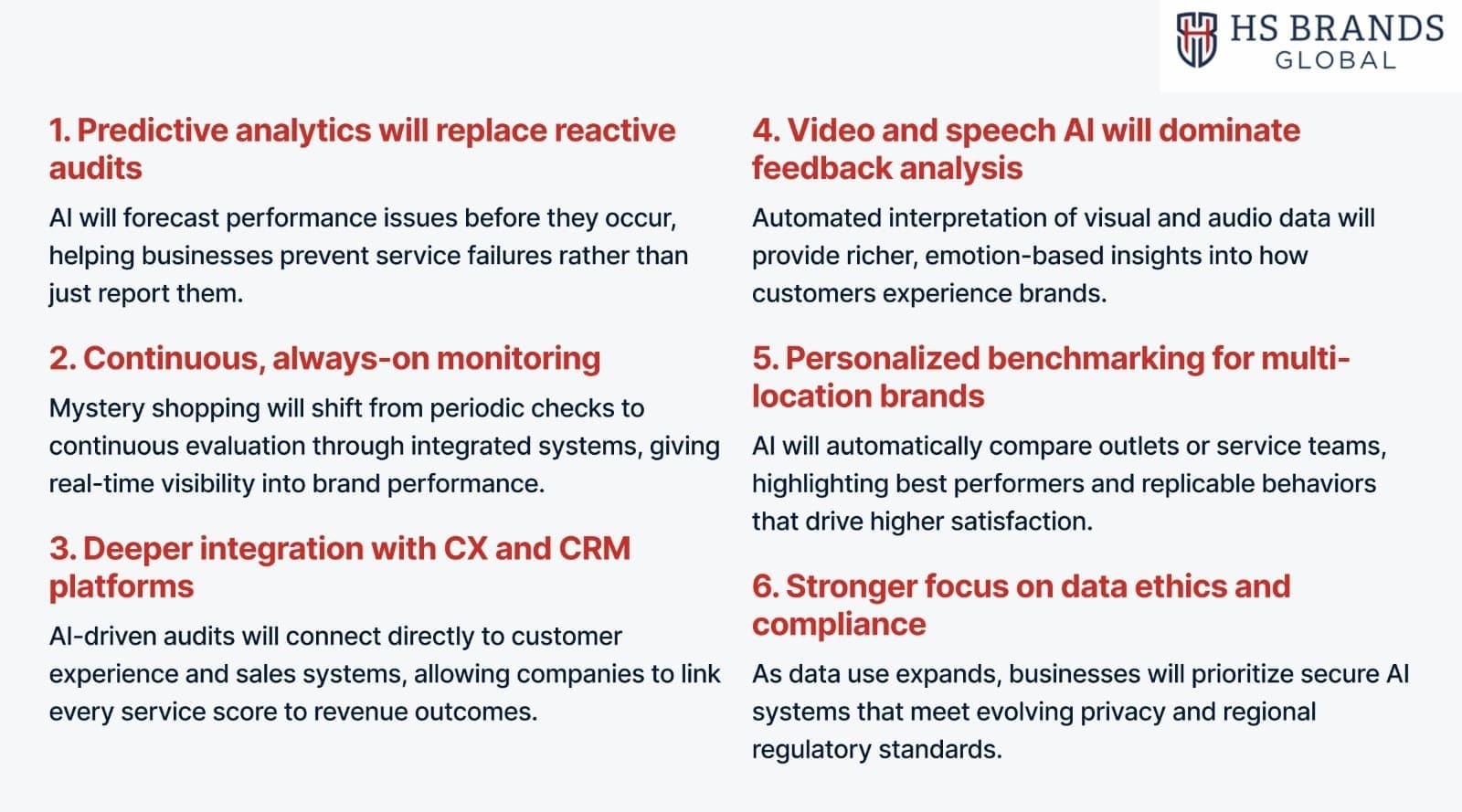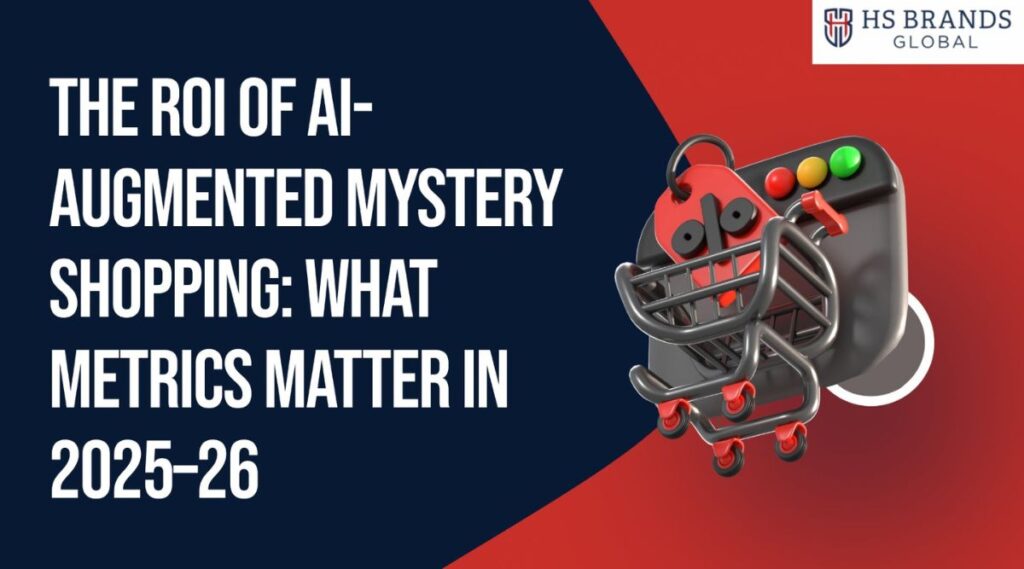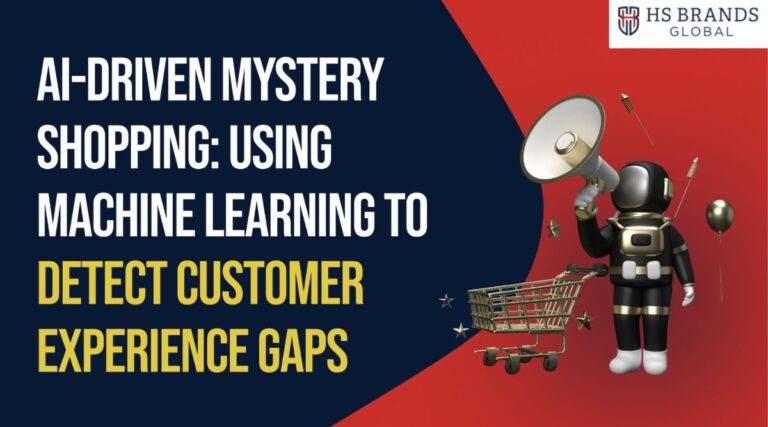AI-augmented mystery shopping combines human evaluation with artificial intelligence to deliver faster, deeper customer insights. In 2025–26, brands measuring ROI focus on speed, accuracy, and experience impact, transforming mystery shopping from a reactive audit into a predictive intelligence system that drives measurable business results.
Early adopters of AI-driven mystery shopping report up to 30 % faster insight delivery and 20 % higher customer-experience scores, proving that smart automation can significantly amplify ROI when integrated across retail, hospitality, and service operations.
As customer expectations evolve across Asia’s dynamic markets, brands can no longer rely on manual audits alone. AI now powers real-time feedback loops, multi-location evaluations, and data-backed actions that directly improve customer satisfaction, compliance, and profitability.
In this article, we’ll explore how AI-augmented mystery shopping delivers measurable ROI, the key metrics that matter most in 2025–26, and how HS Brands Asia is helping leading businesses turn insights into growth.
What Is AI-Augmented Mystery Shopping?
AI-augmented mystery shopping is the next evolution of traditional customer experience auditing. It blends the human touch of real mystery shoppers with the analytical power of artificial intelligence (AI) to uncover service gaps, compliance issues, and customer experience opportunities faster and more accurately than ever before.
In simple terms, AI tools collect and analyze mystery shopping data, including photos, videos, audio, and written reports, to detect trends, highlight service inconsistencies, and recommend improvements automatically.
Unlike traditional audits, where data analysis is manual and time-consuming, AI processes thousands of observations in minutes using technologies such as:
- Natural Language Processing (NLP) to analyze shopper feedback and sentiment.
- Computer Vision to verify visual compliance, shelf layouts, or signage.
- Speech Analytics to evaluate tone, empathy, and communication quality in voice interactions.
- Predictive Modeling to forecast future service lapses or identify at-risk locations.
Rather than replacing human mystery shoppers, AI enhances their work by handling large-scale data processing, spotting hidden trends, and translating complex insights into measurable business value.
This collaboration between human observation and AI analytics helps brands gain a 360-degree view of the customer journey from digital touchpoints to in-store experiences while improving both efficiency and decision-making accuracy.
Why AI-Driven Mystery Shopping Matters in 2025–26
In 2025–26, mystery shopping is evolving from manual audits to real-time business intelligence powered by AI. For modern enterprises, the shift means faster decisions, measurable ROI, and consistent customer experiences at scale.
AI-driven mystery shopping helps decision-makers convert experience data into tangible business outcomes:
- Real-time insights: AI analyzes interactions instantly, helping teams prevent issues before they impact sales.
- Operational efficiency: Automation reduces reporting time by up to 30% and total program costs by 25%.
- Data-driven decisions: Shopper feedback becomes actionable intelligence without manual analysis.
- Scalable consistency: Audit hundreds of locations or digital touchpoints simultaneously with uniform standards.
- Proven ROI: Better accuracy, faster insights, and improved CX directly translate into business growth.
In Asia’s competitive markets, AI-enabled mystery shopping is how leading businesses protect their reputation, ensure compliance, and build customer loyalty that lasts.
How to Calculate ROI from AI-Augmented Mystery Shopping
For business leaders, the value of AI-augmented mystery shopping lies in measurable impact. ROI is not just about cutting costs — it’s about how AI transforms data into decisions that directly affect revenue, efficiency, and customer experience.
Simple ROI Formula:
ROI = (Total Benefits – Total Costs) ÷ Total Costs × 100
Key areas to measure ROI:
- Cost Efficiency: Track time saved on data collection, report generation, and analysis.
Example: AI reduces manual reporting time by up to 30%, lowering overall program costs by 25%. - Revenue Impact: Measure how quickly identified service issues are resolved and how that improves sales or retention rates.
Example: Faster issue resolution can reduce revenue leakage across multiple stores. - Customer Experience (CX) Gains: Compare pre- and post-AI CSAT or NPS scores to evaluate the qualitative impact on customer satisfaction.
- Operational Consistency: Evaluate performance variance across locations — less variation signals better brand consistency.
- Predictive Value: Measure how accurately AI identifies “at-risk” locations or trends before they escalate into service failures.
For enterprises, tracking ROI through these metrics turns mystery shopping from a compliance exercise into a strategic performance driver. It quantifies what every executive wants to see — time saved, risks reduced, and measurable business growth.
Key Metrics That Matter for Measuring ROI
To measure the true ROI of AI-augmented mystery shopping, businesses must focus on metrics that connect customer experience improvements with financial performance. The goal is to identify where AI creates the most value in efficiency, accuracy, and long-term brand impact.
Operational Metrics
Show how efficiently your program runs.
- Audit cycle time: Track how quickly audits move from execution to actionable insights.
- Cost per audit: Compare AI-enabled audits against traditional ones to quantify efficiency.
- Coverage rate: Measure how many locations or touchpoints are analyzed within a set time frame.
Quality Metrics
Reveal how well AI enhances the accuracy and depth of your insights.
- Compliance rate: Percentage of locations meeting brand and service standards.
- Error detection rate: Number of issues identified per audit compared to previous cycles.
- Time to resolution: How quickly flagged issues are addressed and resolved.
Customer Impact Metrics
Connect service improvements directly to customer outcomes.
- Customer Satisfaction (CSAT): Measure improvement after AI-powered interventions.
- Net Promoter Score (NPS): Assess loyalty shifts following consistent service delivery.
- Retention or repeat purchase rate: Quantify financial impact from better experiences.
AI-Specific Metrics
Indicate how effectively AI contributes to results.
- Analysis speed: How fast AI processes data and generates reports.
- Prediction accuracy: How well AI forecasts potential service risks or trends.
- Adoption rate: Percentage of total audits processed through AI versus manual review.
By monitoring these metrics consistently, decision-makers can see where AI delivers the strongest returns and optimize their mystery shopping strategy for maximum business impact.
Best Practices to Maximize ROI
AI-augmented mystery shopping only delivers measurable ROI when it’s applied strategically. For B2B organizations, success depends on combining the right tools, clear goals, and a commitment to action.
Start with clear objectives
Define what success means — cost reduction, faster insights, improved CX, or better compliance. Clear KPIs ensure every AI insight ties back to business goals.
Integrate data systems early
Connect AI audit data with CRM, sales, and CX dashboards. Centralizing results creates a single view of performance and speeds up decision-making.
Pilot before scaling
Run small-scale AI mystery shopping programs to test tools, validate ROI, and fine-tune workflows before expanding organization-wide.
Keep human context in the loop
AI processes data; people interpret nuance. Combine AI accuracy with human insight to ensure reports lead to meaningful action.
Close the feedback loop
Ensure every issue identified leads to action, resolution, and follow-up measurement. Track how improvements affect satisfaction, sales, and brand consistency.
Maintain data privacy and compliance
Use AI tools that meet local regulations, especially when handling customer images, voice, or location data across markets.
Review and optimize regularly
ROI improves when metrics are reviewed frequently. Reassess objectives quarterly to refine data models and focus on the most impactful insights.
When businesses combine structured goals with continuous learning, AI-augmented mystery shopping evolves from an audit tool into a measurable driver of customer loyalty, efficiency, and growth.
Common Challenges and How to Overcome Them
AI-augmented mystery shopping delivers strong ROI, but implementation challenges can limit its impact if not managed proactively. Understanding these hurdles early helps enterprises avoid delays and extract maximum value.
Data integration issues
Challenge: Disconnected systems make it hard to combine AI insights with sales or CX data.
Solution: Use APIs or centralized dashboards that consolidate audit results, enabling faster, data-driven decisions.
Resistance to change
Challenge: Teams may see AI as replacing human input or adding complexity.
Solution: Position AI as a productivity tool, not a replacement. Highlight how it frees teams from manual tasks to focus on customer improvement.
Measuring intangible ROI
Challenge: AI’s value—like faster insights or improved consistency—can be difficult to quantify.
Solution: Establish clear KPIs from day one, such as cost per audit, report turnaround time, or NPS improvement, to make ROI measurable.
Data privacy and compliance
Challenge: Collecting visual or voice data across markets can raise regulatory issues.
Solution: Choose AI partners with strong compliance frameworks and ensure customer data handling follows local privacy laws.
Overreliance on automation
Challenge: Solely depending on AI can lead to context gaps or missed nuances.
Solution: Keep human reviewers involved to interpret results and ensure insights lead to meaningful actions.
Lack of follow-through
Challenge: Insights without action dilute ROI and waste resources.
Solution: Implement a closed-loop feedback process where every issue identified is resolved, verified, and documented.
By anticipating these challenges and embedding strong governance, enterprises can ensure their AI-augmented mystery shopping programs deliver consistent, measurable business returns.
Future Trends: AI Mystery Shopping in 2025–26
The future of mystery shopping is defined by data, automation, and predictive insight. As AI capabilities expand, brands that adapt early will gain a measurable edge in speed, accuracy, and customer retention.

By 2026, mystery shopping will function as a core component of enterprise CX intelligence—providing decision-makers with precise, predictive, and revenue-linked insights that drive measurable growth.
Conclusion: The Future of ROI Is Data-Driven and AI-Powered
AI-augmented mystery shopping is redefining how businesses measure customer experience and operational excellence. It transforms every audit into a stream of real-time intelligence—linking service quality directly to revenue, efficiency, and brand trust.
For decision-makers, the message is clear: adopting AI isn’t about replacing people—it’s about empowering them with insights that scale across markets and drive measurable business results. Companies that invest in AI-driven mystery shopping today will enter 2026 with a sharper understanding of customer behavior, faster decision cycles, and stronger returns on every experience initiative.
HS Brands Asia helps leading businesses achieve exactly that—combining human expertise with AI analytics to deliver mystery shopping programs that create measurable ROI, consistency, and growth.
If your organization is ready to turn customer experience data into real business value, now is the time to invest in AI-augmented mystery shopping—and partner with experts who know how to make it work.







